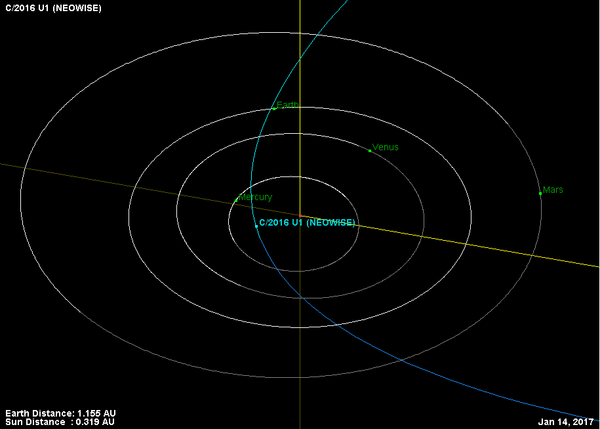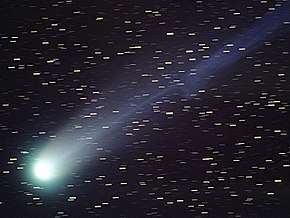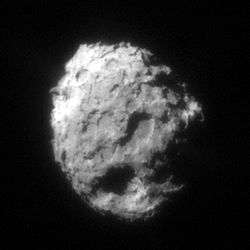C/2016 U1 (NEOWISE)
C/2016 U1 (NEOWISE) is a hyperbolic comet discovered 21 October 2016 by NEOWISE, the asteroid-and-comet-hunting portion of the Wide-Field Infrared Survey Explorer (WISE) mission.[1][2][3] The comet may be visible to skywatchers on Earth, at an estimated +6th magnitude (naked eye brightness),[4] during the first week of 2017 and will be closest to the Sun on 14 January 2017.[2][5] It was closest to the Earth on 13 December 2016 at 106,000,000 km (66,000,000 mi)[4] away; it is not considered a threat to Earth.[2]
| Discovery | |
|---|---|
| Discovered by | NEOWISE project |
| Discovery date | Friday 21 October 2016[1] |
| Orbital characteristics A | |
| Epoch | 2457723.5 (2016-Dec-01.0) TDB[1] Reference: JPL 4 (heliocentric ecliptic J2000)[1] |
| Perihelion | 0.3191 AU[1] |
| Semi-major axis | -3477.5728 AU[1] |
| Eccentricity | 1.0001[1] |
| Inclination | 46.4292 deg[1] |
| Comet total magnitude (M1) | 13.7[1] |
| Comet nuclear magnitude (M2) | 20.0[1] |
| Last perihelion | 14 January 2017 |
| Next perihelion | [none] |
References
- Park, Ryan S.; Chamberlin, Alan B. (30 December 2016). "JPL small-body database browser – C/2016 U1 (NEOWISE)". JPL. Retrieved 30 December 2016.
- Agle, DC; Cantillo, Laurie; Brown, Dwayne (29 December 2016). "NASA's NEOWISE mission spies one comet – maybe two". NASA. Retrieved 29 December 2016.
- Dickinson, David (28 December 2016). "Comet U1 NEOWISE — a possible binocular comet?". Phys.org. Retrieved 30 December 2016.
- MacDonald, Fiona (31 December 2016). "A rare comet is zooming past Earth right now, and you should be able to see it with binoculars". ScienceAlert.com. Retrieved 31 December 2016.
- Williams, Matt (30 December 2016). "NASA'S NEOWISE mission spots new comets". Universe Today. Retrieved 31 December 2016.
External links
- C/2016 U1 at the JPL Small-Body Database

- "C/2016 U1 (data)". "(pictures)". aerith.net.
This article is issued from Wikipedia. The text is licensed under Creative Commons - Attribution - Sharealike. Additional terms may apply for the media files.


